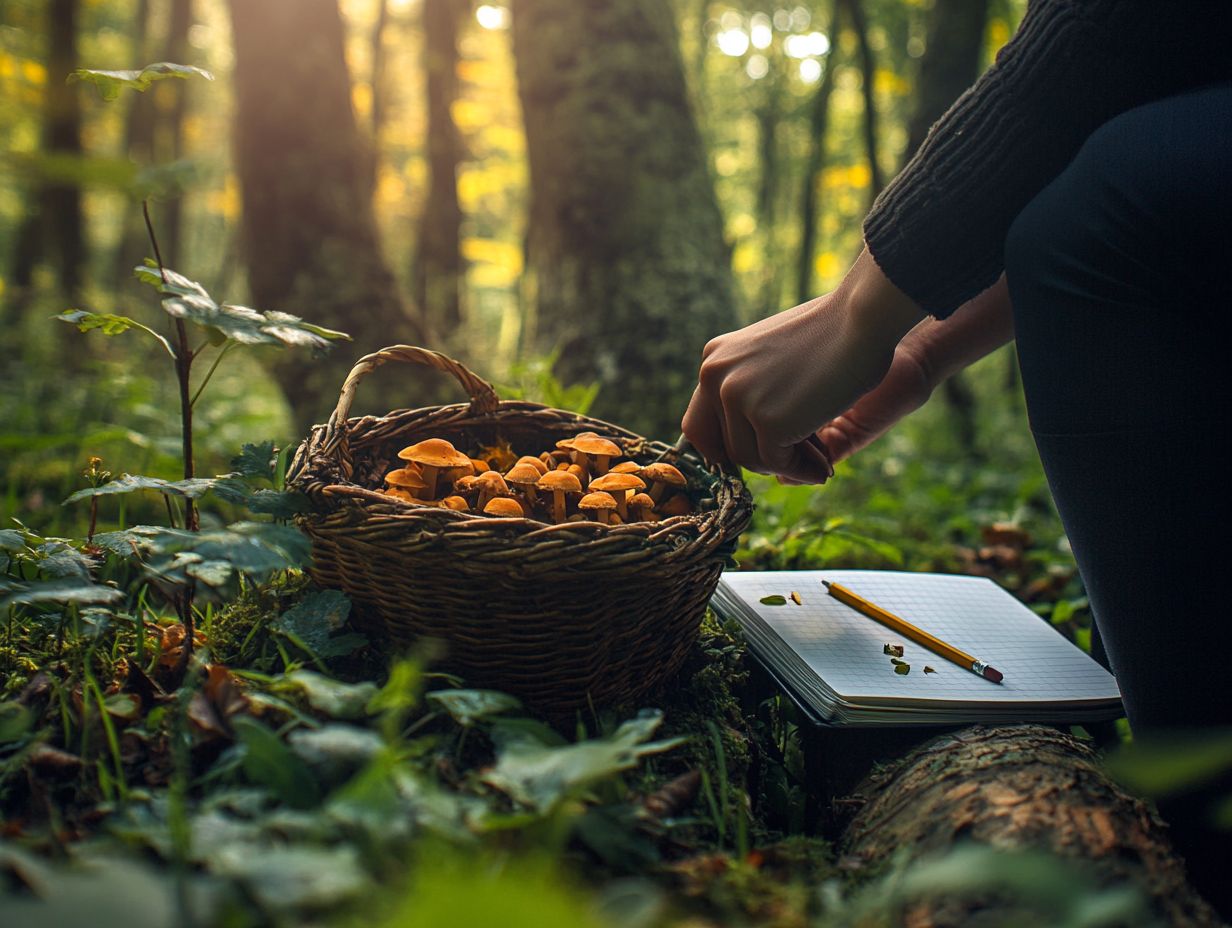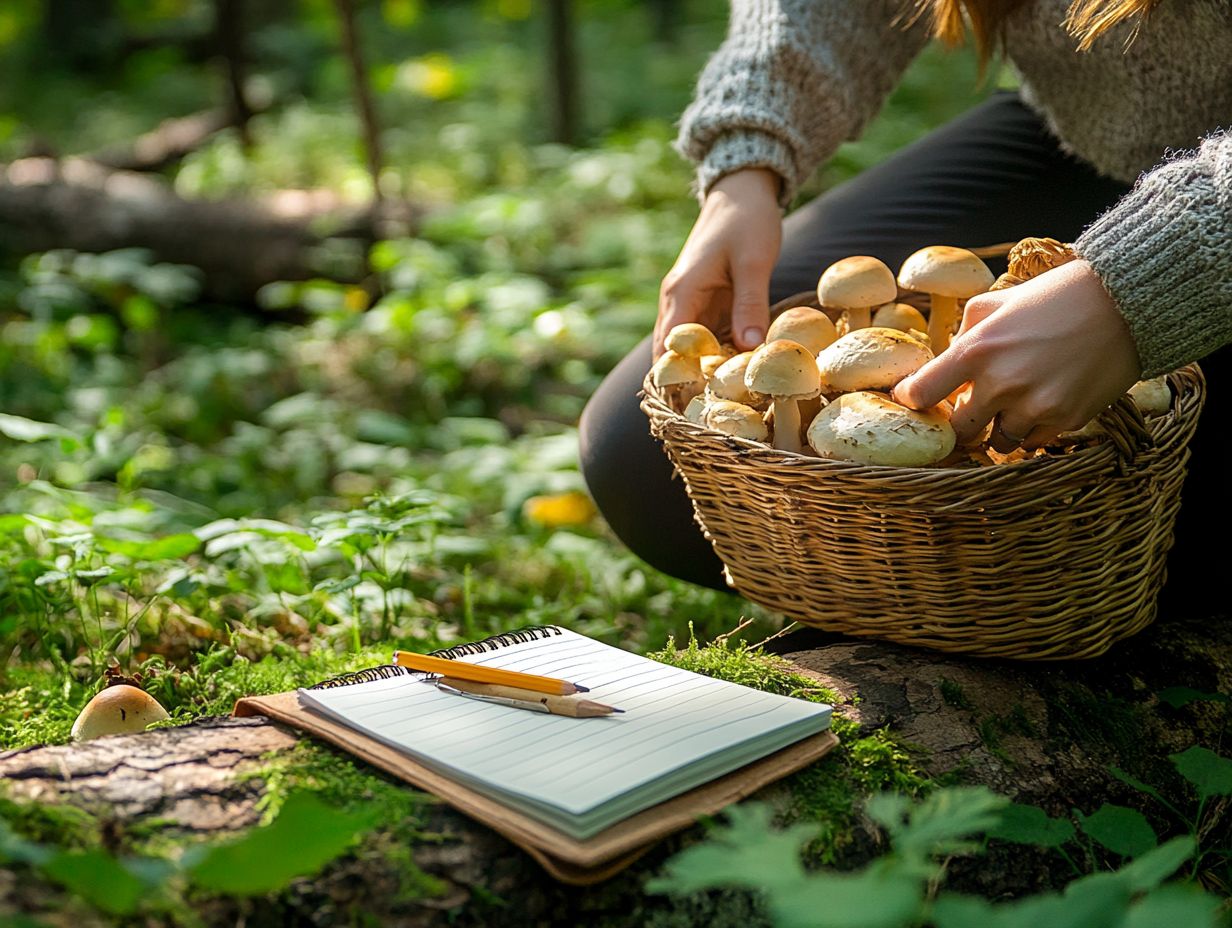How to Document Your Foraging Experiences
Foraging presents a remarkable opportunity to immerse yourself in nature and uncover the wild treasures that surround you. Capturing these experiences can elevate your foraging journey, enabling personal reflection and allowing you to share valuable insights with others.
Let s explore the amazing benefits of documenting your foraging adventures, encompassing journaling, photography, and effective organization tips. Whether you re a seasoned forager or just beginning your journey, these techniques will enrich your experience and inspire those around you.
Contents
Key Takeaways:

- Documenting your foraging experiences allows for personal reflection and learning.
- Sharing your knowledge can inspire others to forage and appreciate nature.
- Journaling, note-taking, and photography are effective documentation tools.
What is Foraging?
Foraging is the skill of seeking out and gathering wild plants, mushrooms, and other natural edibles in their native environments. This practice deepens your connection with nature and promotes the ability to keep the earth healthy and balanced.
By learning to spot edible treasures like wild garlic, nettles, and blackberries, you embrace a lifestyle that values both the earth and its bounties. This is done while adhering to foraging laws and safety guidelines that ensure responsible enjoyment.
For those who embark on the foraging journey, the significance goes far beyond mere sustenance. You ll appreciate the rich tapestry of wild plants in your local surroundings while understanding the importance of ethical practices that allow these plants to flourish. Local herbalists often serve as invaluable guides for beginners, sharing their wisdom on how to recognize beneficial species while steering clear of harmful ones.
Take sweet chestnuts, for example an autumn delight that beckons to be gathered. However, it s essential to remain vigilant not to confuse them with similar-looking, toxic plants. Being aware of invasive species is equally vital, as they can disrupt native ecosystems. This highlights the necessity of responsible foraging.
Responsible foraging not only nourishes you but also supports the ecological balance of the environment and promotes sustainable practices.
Benefits of Documenting Foraging Experiences
Documenting your foraging experiences offers a wealth of benefits, enriching personal reflection and learning while cultivating community engagement. You can learn more about how to record and share your foraging experiences to share insights about your wild food adventures.
By capturing details about edible plants, seasonal produce, and your unique foraging journeys, you can deepen your connection with nature and elevate your cooking fun.
Personal Reflection and Learning
Personal reflection during foraging allows you to connect with the natural world and enhances your understanding of wild food and edible plants. This cultivates your culinary creativity. By documenting your experiences, you can revisit your journeys of identifying plants and discovering the seasonal produce available in your region.
This process of introspection is invaluable; it encourages you to recognize the distinct characteristics of various species while appreciating the unique flavors they can bring to your table.
Engaging in foraging classes or herbal courses amplifies this learning experience, providing structured environments where you can gain insights from experts like Darcy Williamson and John Kallas and share observations with fellow enthusiasts.
Such communal learning about plant relationships deepens your appreciation for local flora and strengthens your bond with your surroundings. This inspires you to experiment with culinary applications in your kitchen and further enrich your connection to nature.
Start documenting your foraging journey today and discover the wonders of nature!
Sharing Knowledge with Others

Sharing knowledge about foraging enriches your community engagement and promotes the practice of sustainable foraging. By connecting with local herbalists and fellow foragers, you can exchange experiences and recipes, fostering a collective appreciation for wild food adventures and ethical harvesting practices.
These connections pave the way for vibrant community events, where you can gather to learn from experienced herbalists about the benefits of various plants. Group foraging outings enhance your learning experience and encourage collaboration in identifying sustainable practices. Sharing unique recipes enables you to explore new flavors and uses for foraged goods, while others might organize workshops that delve into preservation techniques or the medicinal properties of local plants.
This communal knowledge-sharing ultimately cultivates a stronger bond among members and fosters a deeper respect for the environment, ensuring that foraging remains a responsible and enjoyable pursuit for everyone involved.
Tools for Documenting Foraging Experiences
When you set out to document your foraging experiences, equipping yourself with the right tools becomes paramount for capturing the details of your trips. Additionally, learning how to share your foraging skills can enhance your experience and connect you with others who share your passion.
Use journaling, photography, and video to enrich your understanding of edible plants and their identification. Additionally, learning how to map your foraging routes can create invaluable learning resources for both budding and seasoned foragers.
Journaling and Note-taking
Journaling and note-taking help you document your experiences. They allow you to keep track of seasonal produce and plant identification with precision. By recording your observations, you can revisit those unique encounters with nature and deepen your understanding of edible plants.
Through meticulous journaling, you can explore a variety of techniques tailored to your specific needs. Noting the unique characteristics of each plant you encounter like leaf shapes, colors, and distinct features will help you establish a solid foundation for identification.
Location details are equally crucial; document where you found each species, including specifics about the environment like soil type or nearby landmarks. Reflecting on the seasons and how different plants thrive at various times of the year can enhance your appreciation of nature s rhythms.
By emphasizing creativity, incorporate sketches or photographs into your notes. This not only makes the journaling process enjoyable but also provides you with visual references for future foraging expeditions.
Regularly reviewing these entries fosters a deeper connection to the natural world and sharpens your skills over time.
Photography and Video
Photography and video capture the beauty of foraging. They also document how to identify and harvest plants. Utilizing these mediums not only enhances your knowledge but also sparks your culinary creativity.
By showcasing the intricate details of each plant from its leaves to its flowers you can significantly enhance your retention of edible species. Capturing videos of specific cooking processes, such as preparing a delicious dish with your foraged ingredients, adds another valuable layer to your experience.
Organizing visuals can greatly assist you on this journey; tagging plants with their names and characteristics ensures you can quickly access vital information later on. Creating themed albums, such as seasonal harvests or cooking tips, encourages a structured approach that keeps things organized.
Sharing these visual narratives within the foraging community not only fosters collaborative learning but also allows others to gain insights and provide feedback, enriching everyone’s experience in the process.
Start documenting your adventures today to discover the hidden treasures of nature!
Tips for Effective Documentation

Effective documentation of your foraging experiences involves several key practices. This includes how to document your foraging finds, organizing and cataloguing information to enrich your learning process and deepen your understanding of edible plants.
By adopting a structured approach, you can create a valuable resource. It captures your wild food adventures and reflects the intricate relationships you build with the plants around you.
Organizing and Cataloguing
Organizing and cataloging your foraging experiences is essential for building a good understanding of the wild foods and edible plants you encounter on your adventures. By categorizing plants based on their unique characteristics, habitats, and culinary uses, you can create a handy guide that will enhance your future foraging endeavors.
Consider creating a digital or physical catalog to document your discoveries in a structured yet engaging manner. Create a catalog to document your discoveries, organizing your notes by plant type think herbs, mushrooms, and berries while also noting their seasonal availability to highlight the optimal times for harvesting.
Don t miss out! Include sections for cooking suggestions and personal preferences. This transforms your catalog into a top choice that elevates your culinary experiences. By integrating photographs alongside detailed descriptions, you ll assist in visual identification and capture the essence of each discovery, ensuring that your experiences can be revisited and shared with fellow foraging enthusiasts.
Including Relevant Information
Incorporating relevant information into your foraging documentation is essential for ensuring safety and enhancing the accuracy of plant identification. By including details such as habitat, growth patterns, and safety guidelines, you create a helpful guide that serves both personal enjoyment and community sharing. If you’re new to this practice, check out how to start foraging as a hobby for valuable insights.
It’s crucial to document the distinguishing characteristics of each plant, like leaf shapes, flower colors, and seasonal variations. These specifics facilitate accurate identification and enrich your overall learning experience.
Personal insights, such as taste notes or cooking tips, can elevate your documentation. This transforms it into a valuable resource for others. Here s what to capture:
- The date and location of your foraging
- The specific conditions of the area
- Any potential look-alikes to avoid
By prioritizing thorough and safe documentation, you encourage safe foraging and effectively share your knowledge with others.
Frequently Asked Questions
What s foraging all about?

Foraging is the act of gathering wild, edible plants and fungi. Documenting your foraging experiences helps you record your findings, track your progress, and learn how to preserve your foraging finds to share your knowledge with others.
How can I document my foraging adventures?
There are various ways to document your foraging experiences. You can keep a journal or log, create a photo album or scrapbook, make notes on a map, or even start a blog or social media account.
What information should I include in my documentation?
When documenting your foraging experiences, be sure to include the date, location, type of plant or fungi, any special characteristics, and observations about the surroundings or environment. You can also add notes on taste, texture, and uses in cooking for the plants, and if you’re interested in sharing your expertise, check out how to share your foraging knowledge.
Is there a certain format or structure I should follow when documenting?
The format and structure of your documentation can be completely up to you. However, it’s helpful to have a consistent system that allows for easy organization and reference. You may want to use categories or tags to group similar plants together.
How can I ensure accuracy in my documentation?
To ensure accuracy, it’s important to properly identify the plants and fungi you are documenting. Use reliable resources such as field guides or consult with a local expert. Take detailed notes and photos to help with identification.
Benefits of Documenting Your Foraging Experiences
Documenting your foraging adventures helps you track your progress.
It also allows you to share your knowledge with others.
This practice educates people about foraging in a way that protects our environment.
By promoting awareness, you can inspire others to join you on this exciting journey!






